Amir Atapour-Abarghouei
KD360-VoxelBEV: LiDAR and 360-degree Camera Cross Modality Knowledge Distillation for Bird's-Eye-View Segmentation
Dec 17, 2025

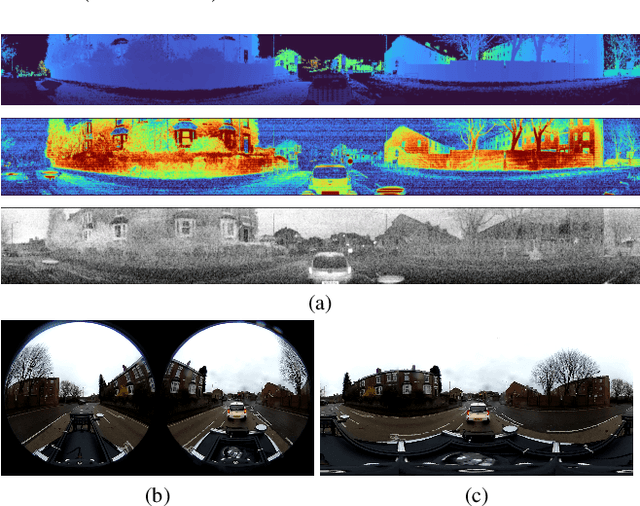

Abstract:We present the first cross-modality distillation framework specifically tailored for single-panoramic-camera Bird's-Eye-View (BEV) segmentation. Our approach leverages a novel LiDAR image representation fused from range, intensity and ambient channels, together with a voxel-aligned view transformer that preserves spatial fidelity while enabling efficient BEV processing. During training, a high-capacity LiDAR and camera fusion Teacher network extracts both rich spatial and semantic features for cross-modality knowledge distillation into a lightweight Student network that relies solely on a single 360-degree panoramic camera image. Extensive experiments on the Dur360BEV dataset demonstrate that our teacher model significantly outperforms existing camera-based BEV segmentation methods, achieving a 25.6\% IoU improvement. Meanwhile, the distilled Student network attains competitive performance with an 8.5\% IoU gain and state-of-the-art inference speed of 31.2 FPS. Moreover, evaluations on KITTI-360 (two fisheye cameras) confirm that our distillation framework generalises to diverse camera setups, underscoring its feasibility and robustness. This approach reduces sensor complexity and deployment costs while providing a practical solution for efficient, low-cost BEV segmentation in real-world autonomous driving.
BcQLM: Efficient Vision-Language Understanding with Distilled Q-Gated Cross-Modal Fusion
Sep 10, 2025Abstract:As multimodal large language models (MLLMs) advance, their large-scale architectures pose challenges for deployment in resource-constrained environments. In the age of large models, where energy efficiency, computational scalability and environmental sustainability are paramount, the development of lightweight and high-performance models is critical for real-world applications. As such, we propose a lightweight MLLM framework for end-to-end visual question answering. Our proposed approach centres on BreezeCLIP, a compact yet powerful vision-language encoder optimised for efficient multimodal understanding. With only 1.2 billion parameters overall, our model significantly reduces computational cost while achieving performance comparable to standard-size MLLMs. Experiments conducted on multiple datasets further validate its effectiveness in balancing accuracy and efficiency. The modular and extensible design enables generalisation to broader multimodal tasks. The proposed lightweight vision-language framework is denoted as BcQLM (BreezeCLIP-enhanced Q-Gated Multimodal Language Model). It offers a promising path toward deployable MLLMs under practical hardware constraints. The source code is available at https://github.com/thico0224/BcQLM.
FineCausal: A Causal-Based Framework for Interpretable Fine-Grained Action Quality Assessment
Mar 31, 2025Abstract:Action quality assessment (AQA) is critical for evaluating athletic performance, informing training strategies, and ensuring safety in competitive sports. However, existing deep learning approaches often operate as black boxes and are vulnerable to spurious correlations, limiting both their reliability and interpretability. In this paper, we introduce FineCausal, a novel causal-based framework that achieves state-of-the-art performance on the FineDiving-HM dataset. Our approach leverages a Graph Attention Network-based causal intervention module to disentangle human-centric foreground cues from background confounders, and incorporates a temporal causal attention module to capture fine-grained temporal dependencies across action stages. This dual-module strategy enables FineCausal to generate detailed spatio-temporal representations that not only achieve state-of-the-art scoring performance but also provide transparent, interpretable feedback on which features drive the assessment. Despite its strong performance, FineCausal requires extensive expert knowledge to define causal structures and depends on high-quality annotations, challenges that we discuss and address as future research directions. Code is available at https://github.com/Harrison21/FineCausal.
Deep Learning-Enhanced Visual Monitoring in Hazardous Underwater Environments with a Swarm of Micro-Robots
Mar 04, 2025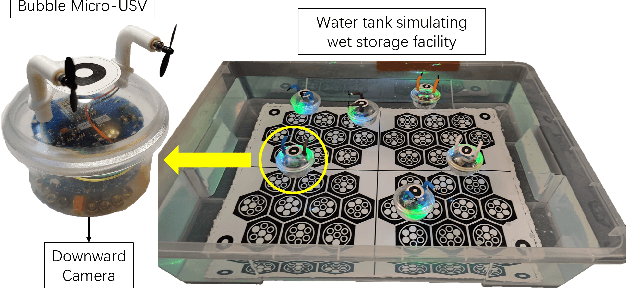
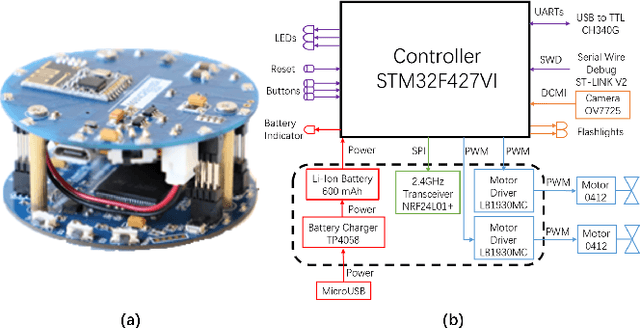
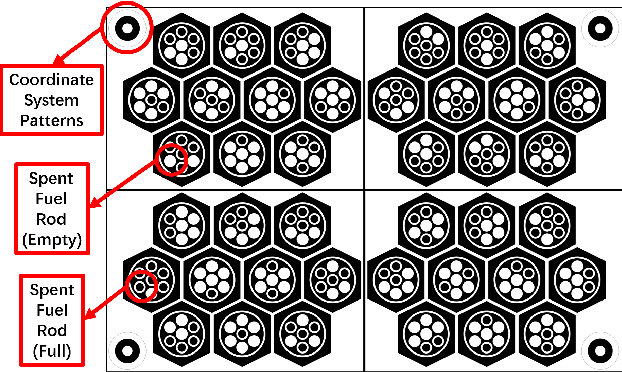
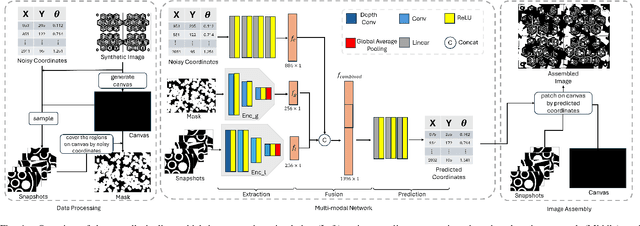
Abstract:Long-term monitoring and exploration of extreme environments, such as underwater storage facilities, is costly, labor-intensive, and hazardous. Automating this process with low-cost, collaborative robots can greatly improve efficiency. These robots capture images from different positions, which must be processed simultaneously to create a spatio-temporal model of the facility. In this paper, we propose a novel approach that integrates data simulation, a multi-modal deep learning network for coordinate prediction, and image reassembly to address the challenges posed by environmental disturbances causing drift and rotation in the robots' positions and orientations. Our approach enhances the precision of alignment in noisy environments by integrating visual information from snapshots, global positional context from masks, and noisy coordinates. We validate our method through extensive experiments using synthetic data that simulate real-world robotic operations in underwater settings. The results demonstrate very high coordinate prediction accuracy and plausible image assembly, indicating the real-world applicability of our approach. The assembled images provide clear and coherent views of the underwater environment for effective monitoring and inspection, showcasing the potential for broader use in extreme settings, further contributing to improved safety, efficiency, and cost reduction in hazardous field monitoring. Code is available on https://github.com/ChrisChen1023/Micro-Robot-Swarm.
SEM-Net: Efficient Pixel Modelling for image inpainting with Spatially Enhanced SSM
Nov 10, 2024



Abstract:Image inpainting aims to repair a partially damaged image based on the information from known regions of the images. \revise{Achieving semantically plausible inpainting results is particularly challenging because it requires the reconstructed regions to exhibit similar patterns to the semanticly consistent regions}. This requires a model with a strong capacity to capture long-range dependencies. Existing models struggle in this regard due to the slow growth of receptive field for Convolutional Neural Networks (CNNs) based methods and patch-level interactions in Transformer-based methods, which are ineffective for capturing long-range dependencies. Motivated by this, we propose SEM-Net, a novel visual State Space model (SSM) vision network, modelling corrupted images at the pixel level while capturing long-range dependencies (LRDs) in state space, achieving a linear computational complexity. To address the inherent lack of spatial awareness in SSM, we introduce the Snake Mamba Block (SMB) and Spatially-Enhanced Feedforward Network. These innovations enable SEM-Net to outperform state-of-the-art inpainting methods on two distinct datasets, showing significant improvements in capturing LRDs and enhancement in spatial consistency. Additionally, SEM-Net achieves state-of-the-art performance on motion deblurring, demonstrating its generalizability. Our source code will be released in https://github.com/ChrisChen1023/SEM-Net.
MxT: Mamba x Transformer for Image Inpainting
Jul 26, 2024Abstract:Image inpainting, or image completion, is a crucial task in computer vision that aims to restore missing or damaged regions of images with semantically coherent content. This technique requires a precise balance of local texture replication and global contextual understanding to ensure the restored image integrates seamlessly with its surroundings. Traditional methods using Convolutional Neural Networks (CNNs) are effective at capturing local patterns but often struggle with broader contextual relationships due to the limited receptive fields. Recent advancements have incorporated transformers, leveraging their ability to understand global interactions. However, these methods face computational inefficiencies and struggle to maintain fine-grained details. To overcome these challenges, we introduce MxT composed of the proposed Hybrid Module (HM), which combines Mamba with the transformer in a synergistic manner. Mamba is adept at efficiently processing long sequences with linear computational costs, making it an ideal complement to the transformer for handling long-scale data interactions. Our HM facilitates dual-level interaction learning at both pixel and patch levels, greatly enhancing the model to reconstruct images with high quality and contextual accuracy. We evaluate MxT on the widely-used CelebA-HQ and Places2-standard datasets, where it consistently outperformed existing state-of-the-art methods.
Insights from the Use of Previously Unseen Neural Architecture Search Datasets
Apr 02, 2024Abstract:The boundless possibility of neural networks which can be used to solve a problem -- each with different performance -- leads to a situation where a Deep Learning expert is required to identify the best neural network. This goes against the hope of removing the need for experts. Neural Architecture Search (NAS) offers a solution to this by automatically identifying the best architecture. However, to date, NAS work has focused on a small set of datasets which we argue are not representative of real-world problems. We introduce eight new datasets created for a series of NAS Challenges: AddNIST, Language, MultNIST, CIFARTile, Gutenberg, Isabella, GeoClassing, and Chesseract. These datasets and challenges are developed to direct attention to issues in NAS development and to encourage authors to consider how their models will perform on datasets unknown to them at development time. We present experimentation using standard Deep Learning methods as well as the best results from challenge participants.
HINT: High-quality INPainting Transformer with Mask-Aware Encoding and Enhanced Attention
Feb 22, 2024Abstract:Existing image inpainting methods leverage convolution-based downsampling approaches to reduce spatial dimensions. This may result in information loss from corrupted images where the available information is inherently sparse, especially for the scenario of large missing regions. Recent advances in self-attention mechanisms within transformers have led to significant improvements in many computer vision tasks including inpainting. However, limited by the computational costs, existing methods cannot fully exploit the efficacy of long-range modelling capabilities of such models. In this paper, we propose an end-to-end High-quality INpainting Transformer, abbreviated as HINT, which consists of a novel mask-aware pixel-shuffle downsampling module (MPD) to preserve the visible information extracted from the corrupted image while maintaining the integrity of the information available for high-level inferences made within the model. Moreover, we propose a Spatially-activated Channel Attention Layer (SCAL), an efficient self-attention mechanism interpreting spatial awareness to model the corrupted image at multiple scales. To further enhance the effectiveness of SCAL, motivated by recent advanced in speech recognition, we introduce a sandwich structure that places feed-forward networks before and after the SCAL module. We demonstrate the superior performance of HINT compared to contemporary state-of-the-art models on four datasets, CelebA, CelebA-HQ, Places2, and Dunhuang.
INCLG: Inpainting for Non-Cleft Lip Generation with a Multi-Task Image Processing Network
May 17, 2023
Abstract:We present a software that predicts non-cleft facial images for patients with cleft lip, thereby facilitating the understanding, awareness and discussion of cleft lip surgeries. To protect patients privacy, we design a software framework using image inpainting, which does not require cleft lip images for training, thereby mitigating the risk of model leakage. We implement a novel multi-task architecture that predicts both the non-cleft facial image and facial landmarks, resulting in better performance as evaluated by surgeons. The software is implemented with PyTorch and is usable with consumer-level color images with a fast prediction speed, enabling effective deployment.
Predicting the Performance of a Computing System with Deep Networks
Feb 27, 2023Abstract:Predicting the performance and energy consumption of computing hardware is critical for many modern applications. This will inform procurement decisions, deployment decisions, and autonomic scaling. Existing approaches to understanding the performance of hardware largely focus around benchmarking -- leveraging standardised workloads which seek to be representative of an end-user's needs. Two key challenges are present; benchmark workloads may not be representative of an end-user's workload, and benchmark scores are not easily obtained for all hardware. Within this paper, we demonstrate the potential to build Deep Learning models to predict benchmark scores for unseen hardware. We undertake our evaluation with the openly available SPEC 2017 benchmark results. We evaluate three different networks, one fully-connected network along with two Convolutional Neural Networks (one bespoke and one ResNet inspired) and demonstrate impressive $R^2$ scores of 0.96, 0.98 and 0.94 respectively.
 Add to Chrome
Add to Chrome Add to Firefox
Add to Firefox Add to Edge
Add to Edge